Melodic Minor Modes Made Easy
Learning how to play the seven modes of melodic minor is an essential skill any guitarist should have in their soloing tool belt.
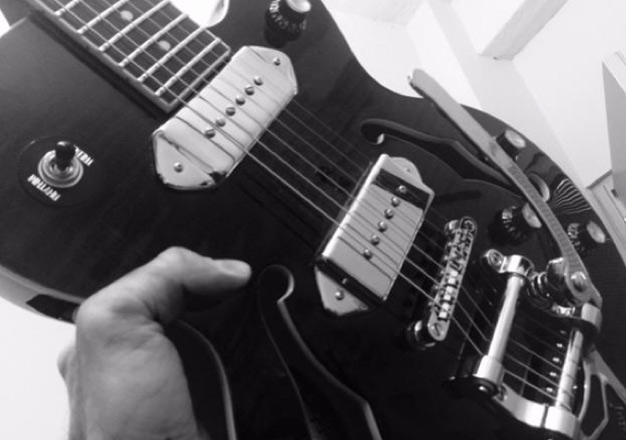
When learning how to play jazz, and other improvisational genres of music, learning how to play the seven modes of melodic minor is an essential skill any guitarist should have in their soloing tool belt.
While we know that learning the seven modes of melodic minor is important, sometimes it can seem like a tough task, and we feel we have to start from scratch when learning these seven modes.
But that doesn’t have to be the case.
In this lesson, you will learn how to simply change one note of each major mode in order to quickly learn all seven modes of the melodic minor scale.
If you are new to the major modes, check out my previous lesson, Major Modes Made Easy, for a refresher on these important melodic devices.
Melodic Minor Mode 1
To begin, let’s take a look at how you can alter one note from the Ionian mode to create the first mode of melodic minor, otherwise known as the melodic minor scale itself.
In order to do this, you play an Ionian mode but lower the third note of the fingering to form the first mode of melodic minor. Because of this alteration, you can think of the MM 1 fingering as being an Ionian b3 shape.
Here is how those two interval patterns compare.
Ionian: R 2 3 4 5 6 7
MM 1: R 2 b3 4 5 6 7
Here's how that interval pattern looks on the fretboard, with one note difference between the two being indicated by the blue highlight in the MM 1 shape.
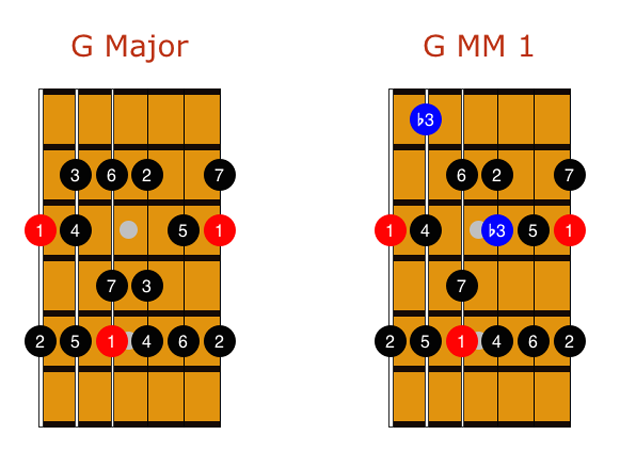
Once you have learned the MM 1 shape, you can practice applying it to a minor family chord, such as m7, m6, m9, or mMaj7, in order to bring this shape to your improvisational practice as well as technical.
Melodic Minor Mode 2
Let’s now take a look at how you can alter one note from the Dorian mode to create the second mode of melodic minor. In order to do this, you play a Dorian mode but lower the 2nd note of the fingering to form the second mode of melodic minor.
Because of this alteration, you can think of the MM 2 fingering as being a Dorian b2 shape.
Here is how those two interval patterns compare.
Dorian: R 2 b3 4 5 6 b7
MM 2: R b2 b3 4 5 6 b7
Here's how that interval pattern looks on the fretboard, with one note difference between the two being indicated by the blue highlight in the MM 2 shape.
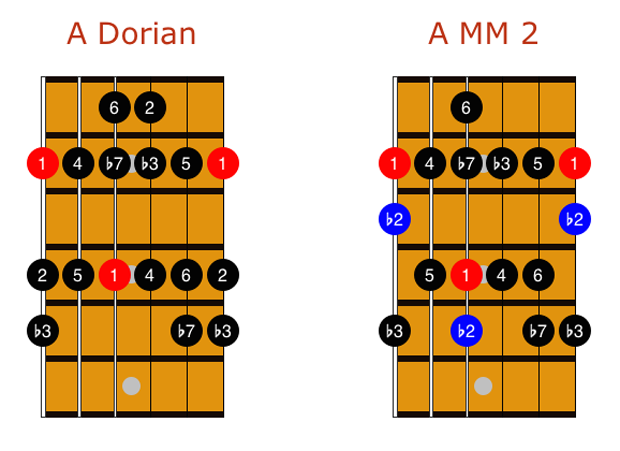
Once you've learned the MM 2 shape, you can practice soloing with this mode over a 7th chord, bringing out a 13susb9 sound, in order to apply this shape to your improvisational practice as well as technical.
Melodic Minor Mode 3
We’ll now move on to altering one note from the Phrygian mode to create the third mode of melodic minor, otherwise known as the Lydian augmented scale.
In order to do this, you play a Phrygian mode but lower the root note of the fingering to form the third mode of melodic minor. Because of this alteration, you can think of the MM 3 fingering as being a Phrygian b1 shape.
This may seem funny, lowering the root note, but it makes it very easy to turn a Phrygian mode into the third mode of melodic minor on the fretboard from a fingering standpoint.
Here's how those two interval patterns compare.
Phrygian: R b2 b3 4 5 b6 b7
MM 3: R 2 3 #4 #5 6 7 (or bR b2 b3 4 5 b6 b7 when compard to Phrygian)
Here's how that interval pattern looks on the fretboard, with one note difference between the two being indicated by the blue highlight in the MM 3 shape.
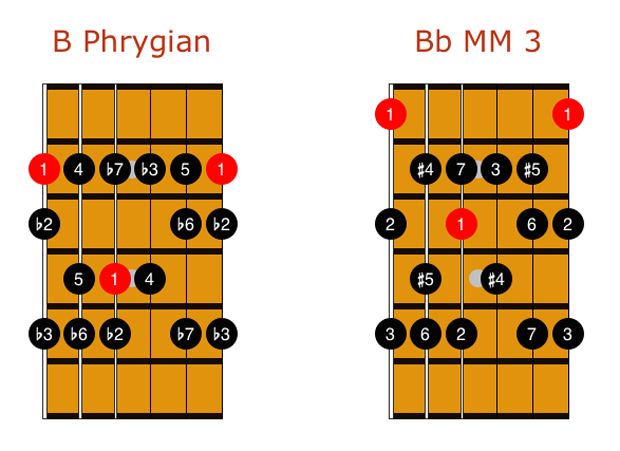
Once you have learned the MM 3 shape you can practice soloing with this mode over a maj7th chord, bringing out a maj7#5 sound, in order to apply this shape to your improvisational practice as well as technical.
Melodic Minor Mode 4
Let’s now alter one note from the Lydian Mode to create the fourth mode of Melodic Minor, otherwise known as the Lydian dominant scale.
- In order to do this, you play a Lydian mode but lower the seventh note of the fingering to form the fourth mode of melodic minor.
- Because of this alteration, you can think of the MM 4 fingering as being a Lydian b7 shape.
Here's how those two interval patterns compare.
Lydian: R 2 3 #4 5 6 7
MM 4: R 2 3 #4 5 6 b7
Here's how that interval pattern looks on the fretboard, with one note difference between the two being indicated by the blue highlight in the MM 4 shape.
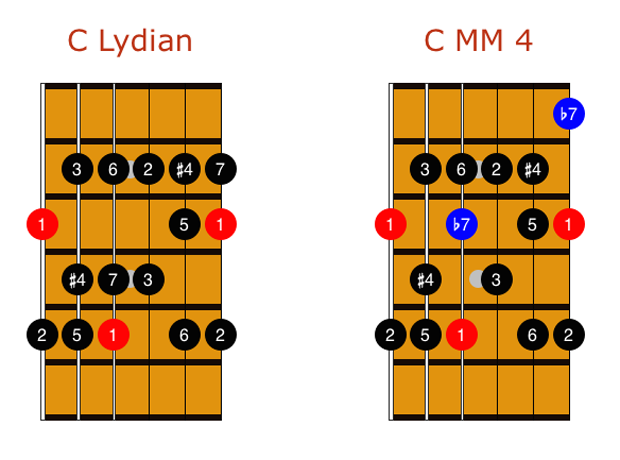
Once you've learned the MM 4 shape you can practice soloing with this mode over a dominant family chord such as 7th, 9th or 13th, bringing out a #11 sound, in order to apply this shape to your improvisational practice as well as technical.
Melodic Minor Mode 5
Moving on, you can now alter one note from the Mixolydian mode to create the fifth mode of melodic minor. In order to do this, you play a Mixolydian mode but lower the sixth note of the fingering to form the fifth mode of melodic minor.
Because of this alteration, you can think of the MM 5 fingering as being a Mixolydian b6 shape. Here's how those two interval patterns compare.
Mixolydian: R 2 3 4 5 6 b7
MM 5: R 2 3 4 5 b6 b7
Here's how that interval pattern looks on the fretboard, with one note difference between the two being indicated by the blue highlight in the MM 5 shape.
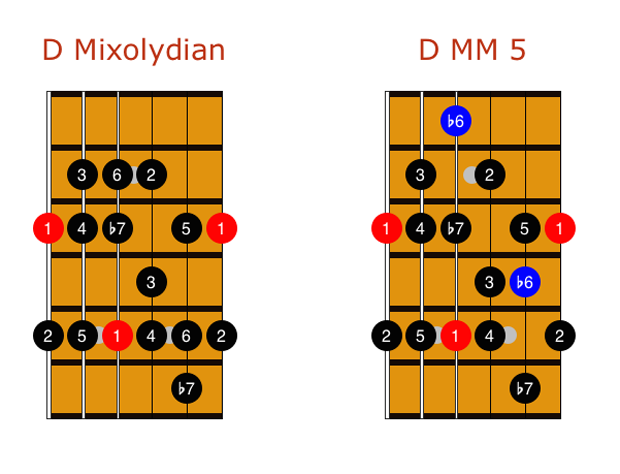
Once you've learned the MM 5 shape, you can practice soloing with this mode over a dominant family chord such as 7th, 9th or 13th, bringing out a b13 sound, in order to apply this shape to your improvisational practice as well as technical.
Melodic Minor Mode 6
Let’s now alter one note from the Aeolian mode to create the sixth mode of melodic minor, otherwise known as the Locrian Natural 2 scale. In order to do this, you play an Aeolian mode but lower the fifth note of the fingering to form the sixth mode of melodic minor.
Because of this alteration, you can think of the MM 6 fingering as being an Aeolian b5 shape.
Here's how those two interval patterns compare.
Aeolian: R 2 b3 4 5 b6 b7
MM 6: R 2 b3 4 b5 b6 b7
Here's how that interval pattern looks on the fretboard, with one note difference between the two being indicated by the blue highlight in the MM 6 shape.
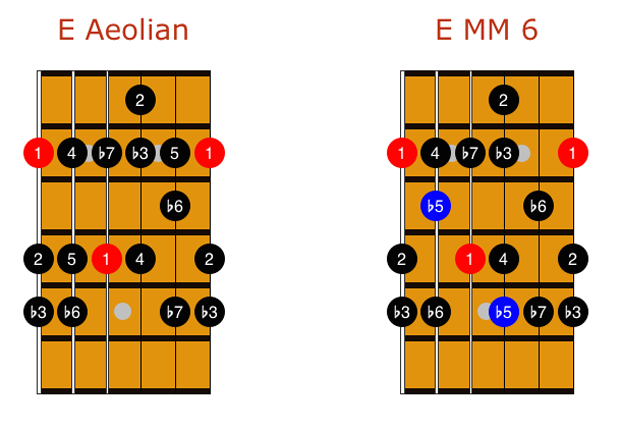
Once you've learned the MM 6 shape, you can practice soloing with this mode over a m7b5 chord in order to apply this shape to your improvisational practice as well as technical.
Melodic Minor Mode 7
Lastly, you can alter one note from the Locrian mode to create the seventh mode of melodic minor, otherwise known as the altered scale. In order to do this, you play a Locrian mode but lower the 4th note of the fingering to form the seventh mode of melodic minor.
Because of this alteration, you can think of the MM 7 fingering as being a Locrian b4 shape.
Here's how those two interval patterns compare.
Locrian: R b2 b3 4 b5 b6 b7
MM 7: R b3 b3 b4 b5 b5 b7
Here's how that interval pattern looks on the fretboard, with one note difference between the two being indicated by the blue highlight in the MM 7 shape.
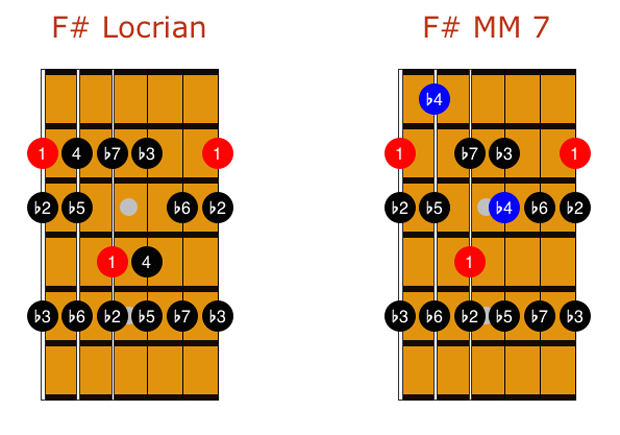
Matt Warnock is the owner of mattwarnockguitar.com, a free website that provides hundreds of lessons and resources designed to help guitarists of all experience levels meet their practice and performance goals. Matt lives in the U.K., where he teaches Skype guitar students all over the world, and is an examiner for the London College of Music (Registry of Guitar Tutors).
Get The Pick Newsletter
All the latest guitar news, interviews, lessons, reviews, deals and more, direct to your inbox!
Matt Warnock is the owner of mattwarnockguitar.com, a free website that provides hundreds of lessons and resources designed to help guitarists of all experience levels meet their practice and performance goals. Matt lives in the UK, where he teaches Skype guitar students all over the world, and is an examiner for the London College of Music (Registry of Guitar Tutors).
“There are so many sounds to be discovered when you get away from using a pick”: Jared James Nichols shows you how to add “snap, crackle and pop” to your playing with banjo rolls and string snaps
Don't let chord inversions bamboozle you. It's simply the case of shuffling the notes around







![Joe Bonamassa [left] wears a deep blue suit and polka-dotted shirt and plays his green refin Strat; the late Irish blues legend Rory Gallagher [right] screams and inflicts some punishment on his heavily worn number one Stratocaster.](https://cdn.mos.cms.futurecdn.net/cw28h7UBcTVfTLs7p7eiLe.jpg)


